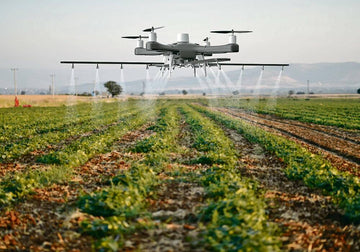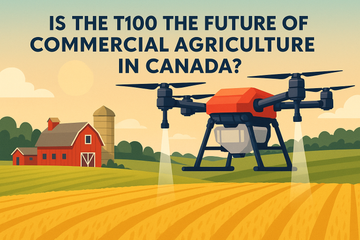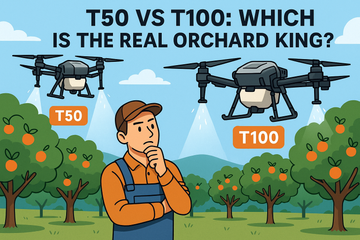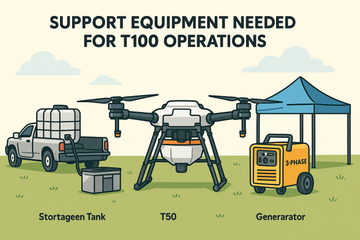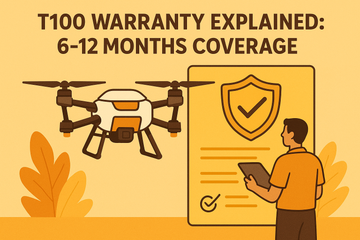The New Era of Canadian Farming: DJI Agras T25 and T50 in Focus
Canadian agriculture is a diverse landscape, from the vast, flat fields of the Prairies to the dense orchards of the Okanagan and Niagara regions. As the industry increasingly turns to technology for efficiency, DJI Agras drones have emerged as essential tools.
Two of the most popular models, the Agras T25 and the Agras T50, are leading this charge. But for a Canadian farmer, the choice between them isn't just about specs—it's about which drone is the right fit for your specific operation and a complex regulatory environment.
T25 vs. T50: A Side-by-Side Look
While both drones share advanced features like dual atomizing sprayers and omnidirectional obstacle sensing, their core differences are crucial.
| Feature | Agras T25 | Agras T50 |
| Spraying Payload | 20 L | 40 L |
| Spreading Payload | 25 kg | 50 kg |
| Operational Efficiency | Up to 12 hectares/hour | Up to 21.3 hectares/hour |
| Key Advantage | Portability and agility | Efficiency and capacity |
The T25 is designed for solo operators. Its compact, foldable frame makes it incredibly easy to transport and set up. The T50, on the other hand, is a true powerhouse, built for maximum efficiency on a grand scale.
Navigating Canadian Regulations: It's Not a Hobby Drone
This is the most critical difference from a Canadian perspective. Due to their weight and use, neither the Agras T25 nor the T50 is a simple fly-and-go device. Both drones fall into the "medium drone" category (over 25 kg), meaning they require specific certification from Transport Canada.
To legally operate an Agras drone in Canada, you must have:
-
Drone Registration: Both drones must be registered with Transport Canada.
-
Pilot Certificate - Advanced Operations: You must hold this license to fly these drones, which involves passing an online exam and an in-person flight review.
-
Special Flight Operations Certificate (SFOC-RPAS): This is the key license for spraying and spreading operations. You cannot legally use your Agras drone for agricultural applications in Canada without an SFOC-RPAS.
This additional regulatory layer is a significant factor in your decision. It requires planning and training, but ensures that you operate safely and legally.
A Drone for Every Canadian Climate and Terrain
The real analysis comes down to where and how you farm in Canada.
Choose the T25 for Varied Terrain and Specialized Crops
The T25’s agility makes it the perfect fit for the diverse Canadian landscape outside the prairies. Its ability to navigate complex terrain and orchards makes it an ideal tool for:
-
Vineyards and Orchards: In British Columbia's Okanagan Valley or Ontario's Niagara Peninsula, the T25’s precise spraying and ability to handle hilly ground are invaluable.
-
Small to Medium-Sized Farms: If you’re a solo operator or have a farm with smaller, more difficult-to-reach plots, the T25’s portability and quick setup save you time and labour.
-
Cold Weather Operations: With an operating temperature range down to -20°C, the T25 is better suited for early spring or late fall work in colder provinces, though proper battery care is still essential.
Choose the T50 for the Prairies and Large-Scale Operations
The T50 is built for one thing: covering vast areas quickly. This makes it a perfect match for the agricultural heartland of Canada.
-
Broadacre Farming: The T50 is made for the expansive grain fields of Saskatchewan, Alberta, and Manitoba. Its massive payload means fewer trips back to the home base for refills, maximizing your uptime during the short spraying windows.
-
High-Volume Spreading: For tasks like broadcasting seeds or dry fertilizer, the T50's large spreading capacity makes it incredibly efficient, far outpacing the T25.
In the end, the right drone depends entirely on your operation. The T25 offers unparalleled agility and is perfect for precision work on smaller, more complex farms. The T50, on the other hand, is the ultimate tool for maximizing efficiency and scale. Either way, both drones represent a significant leap forward for Canadian farmers looking to embrace the future of agritech.
#DJI #DJIAgras #AgricultureDrones #PrecisionAgriculture #DJIT50 #DJIT25 #CanadianFarming #Agritech #FarmTech #DroneCanada #SmartFarming #AgriTech #CanadianAgriculture


